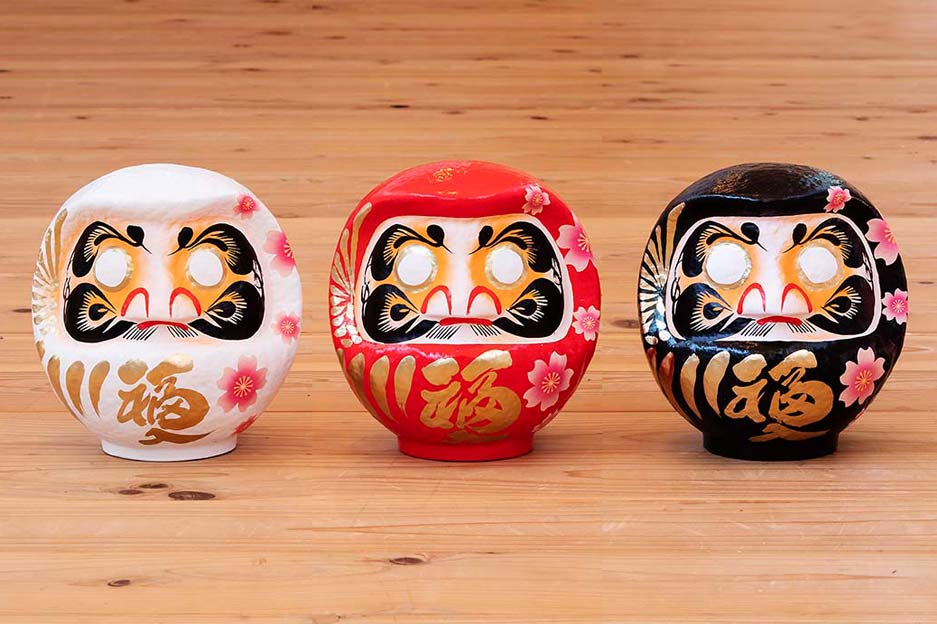Japan is a developed country with an extremely high standard of living. But despite this, people are very superstitious. So, there is a tradition of using charms and mascots. It is about the varieties of Japanese mascots and will be discussed in this article.
Maneki-Neko
Maneki-Neko («Inviting Cat, » «Beckoning Cat, » «Calling Cat, » also known as «Cat of Happiness, » «Cash Cat, » or «Cat of Fortune») is a typical Japanese sculpture, often made of porcelain or ceramics, which is believed to bring its owner good luck. The sculpture depicts a cat with a vertically raised paw and is usually displayed in shop windows, restaurants, and pachinko rooms. A cat with its right paw attracts money, luck, and its left paw - clients. There are also «Maneki-Neko» with two raised paws. 20% of cats are held in the paw of a Coban (Edo gold coin). The Coban is a coin worth one Ryo, but the coin the cat holds says ten million Ryo.
«Maneki-Neko» come in different colors, but traditional ones are sculptures of three-color cats - with white wool and spots. Many Maneki Neko variants are made of clay, porcelain, papier-mache, and wood; even old stone specimens are preserved. The main essential elements are raised paw, bib, color, and coin. As a mascot, «Maneki Neko» appeared only in the second half of the XIX century.
The bib, often ornamented, contacts Dzizo - the patron of children and travelers. Dizzy’s stone sculptures are covered with bibs, usually red, and asked for. Previously, the colors of Maneki Neko were not as diverse as they are today, but they had a specific meaning. Thus, Kyoto merchants loved black cats; they were considered unfavorable in Edo (Tokyo). At the same time, in some places, black variants acted as lucky charms against disease, and red variants - specifically against measles. There are stories about the golden Maneki Neko and the virtuous cat who stole two gold coins from his rich master for a sick neighbor merchant, who constantly treated him with fresh fish. So, a coin appeared on his neck.
Daruma
Daruma is a traditional Japanese chubby doll personified by Bodhidharma, and in Japanese Shinto mythology, it is a deity of happiness. The doll is made of wood, papier-mache, or paper and has no arms or legs: according to legend, after nine years of meditation, Bodhidharma atrophied limbs. The doll is usually painted red or, less often, green, yellow, or white. It depicts a beard and mustache, but the eyes are drawn without pupils.
Daruma is used in the annual New Year’s Day wishing ritual: its owner, having made a wish, draws a pupil in one of the puppet’s eyes. The name of its owner is often written on the chin of the daruma. During the year, the daruma is kept at home in a prominent place, next to other household objects of worship, such as the home Buddhist altar of the butsudan. If by the next new year, the wish comes true, the daruma draws the second eye, and if not, the doll is taken to the temple, burned, and purchased a new one. The burning of the daruma is a purification ritual so that the kami (the spirit, the deity) understand that the one who made the wish does not give up his goal but seeks other ways to realize it.
As a rule, a daruma can be burned only in the temple where it was purchased - for this purpose it is placed a temple seal. It is customary to buy up to one gift a year.
Omamori
Omamori is a Japanese amulet dedicated to a Shinto or Buddhist deity. The word Omamori is a respectful form of Mamori - «protection. » The Omamori tradition is rooted in Shinto. Most often, these are small fabric talismans with paper or wooden inserts on which are inscribed prayers addressed to Shinto or Buddhist deities. In such bags can be sewn plates with images of spirits, Buddhas or saints, sacred texts, and special herbs. But mascots do not necessarily have the shape of a pouch. In principle, Omamori refers to much religious paraphernalia sold in temples.
Kanai Anzen - brings good health and protects from diseases.
Koutsu Anzen - protect travelers.
Emmusubi - bring/protect love.
Anzan - protection for pregnant women.
Gakugyojoju - promote learning.
Shobaihanjo - bring good luck in business.
Japan is hung Omamori: you will meet them in cars, trains, bags, and mobile phones. Do not think of opening purchased Omamori. Otherwise, it will lose the quality of protection. If the money Omamori Shobaihanjo still spoils, keep a piece of snakeskin in your wallet: it will bring you wealth.



POST COMMENTS
0 COMMENT(S)